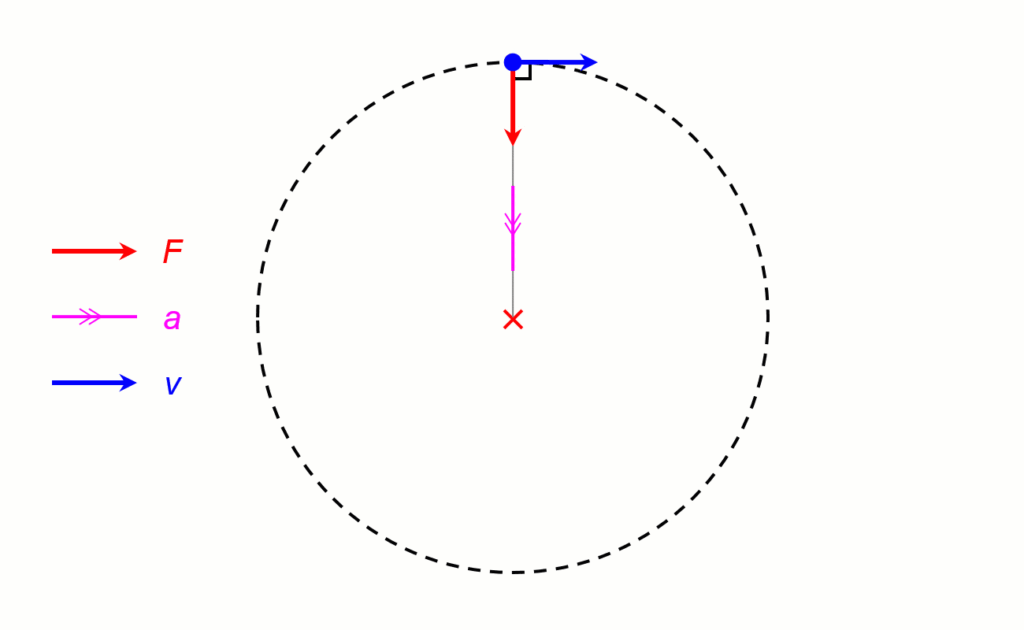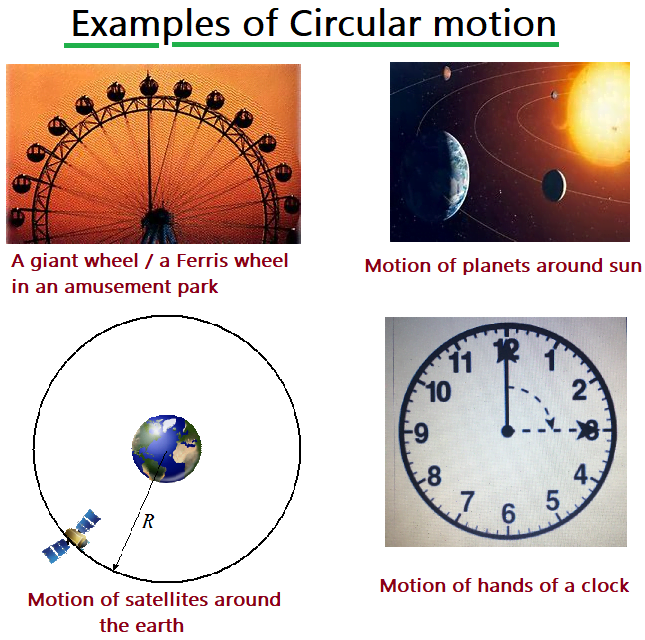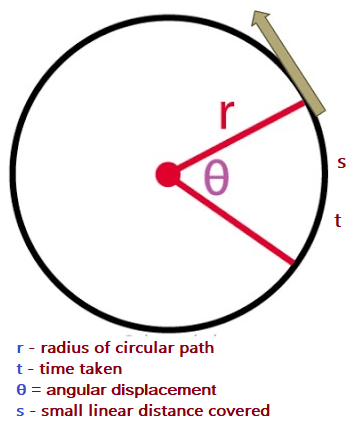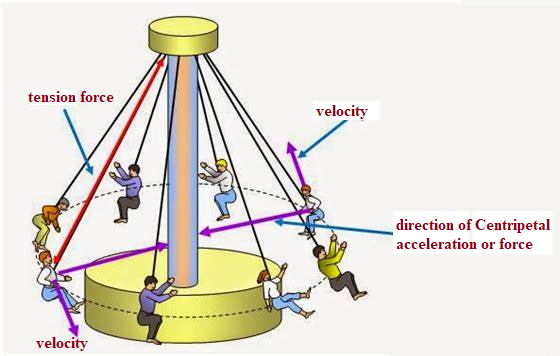Circular motion class 9
Hello, readers! Here, we will learn about circular motion, types of circular motion, their examples, centripetal acceleration, applications of centripetal acceleration and problems based on it. Circular motion class 9
Table of Contents
Click here 🖱️👉 Motion Graphs Class 9 Quiz-2
Circular motion:
The type of motion in which a body moves on a circular path is known as circular motion.
For example: Motion of hands of a watch, motion of wheel, motion of satellites around the earth, a rotating ceiling fan, motion of the blades in a windmill etc.


Click here 🖱️👉Motion NCERT in-text Questions Solution
Angular displacement (θ):
- The angle (θ) covered by a body in given interval of time is known as angular displacement.
- It is denoted by symbol theta (θ).
- SI Unit of angular displacement is radian (rad).
Angular velocity (ω):
The angle covered by a body per unit time is called angular velocity.
It is denoted by symbol omega (ω).
Angular velocity (ω) = angular displacement (θ) / time taken (t)
SI Unit of angular velocity is radian/second (rad/s)

Click here 🖱️👉 Motion NCERT Questions Solution
Types of circular motion:
Circular motion can be either uniform or non-uniform.
| Uniform circular motion | Non-uniform circular motion |
|---|---|
| The type of motion in which the body moves with constant angular velocity is known as uniform circular motion. | The type of motion in which the body moves with variable angular velocity is known as non-uniform circular motion. |
| Centripetal acceleration is not equal to zero have some constant value. | Centripetal acceleration is not equal to zero and variable. |
| Example: Motion of the hands of a watch. | Example: Motion of planet around Sun, motion of wheels of a car. |
Centripetal acceleration:
The acceleration which is responsible for the circular motion of a body is known as centripetal acceleration. Without centripetal acceleration, it is not possible for a body to move in a circular path.
If a body is moving on a circular path of radius ‘r’ with velocity ‘v’ then centripetal acceleration acting on body is equal to v2/r.
Centripetal acceleration = v2/r
Centripetal force:
The force which acts on a body while moving on a circular path is known as the centripetal force. Without centripetal force, it is not possible for a body to move in a circular path. The direction of centripetal force is always radially inward (towards radius inside).
If a body of mass ‘m’ is moving on a circular path of radius ‘r’ with velocity ‘v’ then centripetal force acting on body is equal to mv2/r
Centripetal force = mv2/r

Applications of centripetal force:
When a car is moving on a circular road or turning without slipping safely. Here, adequate centripetal force is required for circular motion, which is provided by the frictional force between the car tyres and the road. If adequate centripetal force is not present, the car can start slipping rather than taking the turn on the road. A reduction in the frictional force may be by any means, like an icy or wet road.
Let’s discuss another example: the movement of the earth around the sun. Here, the centripetal force necessary for the circular motion of the earth around the sun is provided by the gravitational attraction force between the earth and the sun. The same thing happens when the satellites revolve around the earth due to the centripetal force provided by the gravitational attraction imparted by the earth on the satellites.
Centripetal force is also responsible for electrons’ revolution around the nucleus in a circular orbit in an atom. Here, centripetal force is provided by electrostatic attraction between electrons and the nucleus.
Circular Motion Questions & Answers
Question 1:
Give a reason why the acceleration of a body is not equal to zero even when the speed is constant.
Ans: Since acceleration is a vector quantity, it comprises magnitude and direction in both. In circular motion, even if speed is constant, the direction of motion of the body is continuously changing, so the acceleration of a body is not equal to zero .
Question 2:
A particle is executing circular motion with constant speed, is its acceleration also constant?
Answer: When a body moves in a circular motion with constant speed, it has acceleration because the direction of motion of the body changes continuously, and hence velocity changes with a constant magnitude of velocity (speed).
Question 3:
Why does an airplane tilt slightly when it makes a curved flight?
When an airplane takes a curved flight, the weight of the aircraft is used to provide the necessary centripetal force.
Question 4:
If a small can filled with water is rapidly swing in a vertical circle, the water does not fall, why?
Answer: As a bucket is tied to a string and rapidly spins in a vertical circle, the tension force in the string acting upon the bucket provides the necessary centripetal force required for the circular motion and prevents the water from falling outside.
Pages
Circular motion class 9, Circular motion class 9, Circular motion class 9, Circular motion class 9, Circular motion class 9, Circular motion class 9, Circular motion class 9, Circular motion class 9, Circular motion class 9, Circular motion class 9, Circular motion class 9, Circular motion class 9
MY YouTube Channel Link : 👉🖱 https://www.youtube.com/channel/UCGpC7nWE0-bBv9I53MM8qjQ